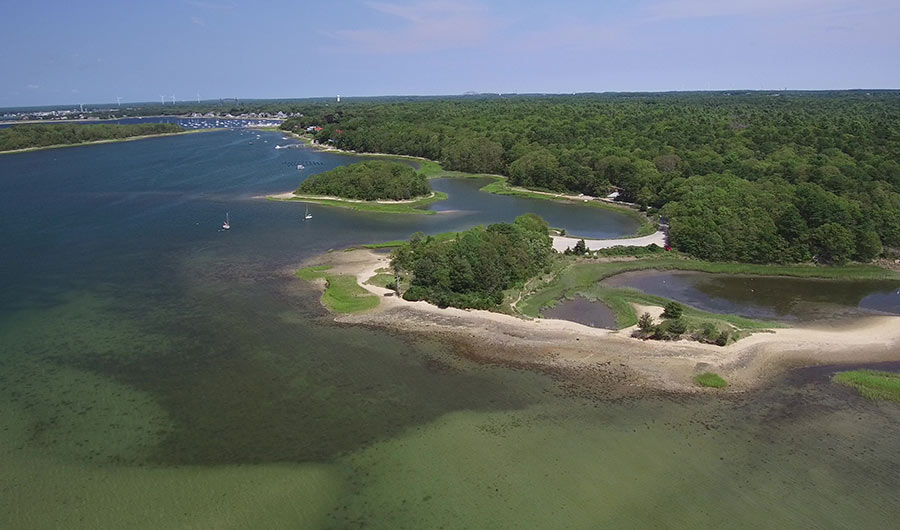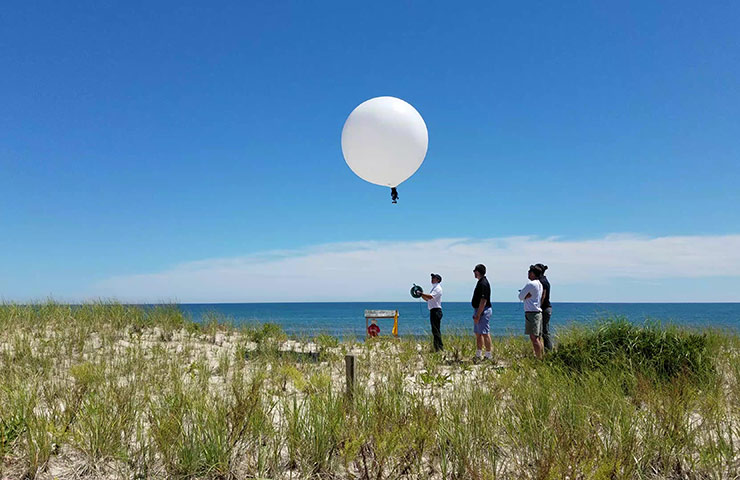Balloon Watches for Sharks and Hurricane Damage

Aerial view of Cape Cod shoreline and waters
Courtesy of Altametry
Image rights: This image may be used by news outlets to accompany this Inside Science story.
(Inside Science) -- A versatile new technology called smart balloons can help monitor two potentially threatening dangers -- great white sharks and high-category hurricanes.
Each balloon, tethered to the ground, floats high above the seascape or landscape while its cameras shoot still photos or stream video of the scene below. Land-based operators can order the balloons' cameras to zoom in on eye-catching items.
The balloons' cameras can detect sharks close to shore, allowing lifeguards to warn swimmers and beachgoers of their presence. The cameras can also track damage from hurricanes on land and water, thus permitting local authorities to prioritize cleanup tasks. And they can spot disturbances in crowds at sports events and other large gatherings, and identify the individuals responsible.
John Ciampa, CEO and founder of the Miami company Altametry, began working on the balloons six years ago, with a grant from the National Science Foundation and help from two universities in Florida. He developed what the company calls SmartBalloons.
Each balloon consists of a polymer so strong that material around a bullet hole will shrink the hole, thus preventing the hydrogen gas inside it from leaking. The balloon’s tether consists of a very light, very strong fiber.
A safety mechanism in the system that connects the balloon to the camera can sense if the balloon is traveling in the wrong direction, take it down safety, and alert the remote human crew to its location.
The balloons' batteries provide between five and six hours of working time, and changing them takes only a few seconds, Ciampa said. After a series of trial and error approaches, the team developed a method of filling the balloon with enough hydrogen from a tank in the trunk of a car to permit it to remain aloft for that amount of time, all the while sending down steady high-resolution images.
After creating the technology, Altametry faced the problem of finding a use for it.
They realized that their balloons had three primary advantages over older surveillance techniques: flexibility, mobility and cost. Unlike airplanes and helicopters, smart balloons don’t need human operators in the sky. And in contrast to drones, they can spend long periods of time in the air at relatively low cost.
The company focused initially on monitoring events for such matters as crowd safety, crime and medical issues.
“For the past two years our SmartBalloons rather than helicopters monitored the Urban Beach Week festival in Miami Beach,” Ciampa said. The balloons also oversaw the 2017 National Governors’ Conference in Providence, Rhode Island, in July.
Altametry has also used its balloons to monitor sharks.

Launching a smart balloon on Cape Cod
Courtesy of Altametry
This image may be used by news outlets to accompany this Inside Science story.
In one experiment off the South Carolina coast, researchers from Ocearch, a nonprofit organization that tracks sharks, relied on video from a SmartBalloon to detect and catch a shark for tagging.
This past summer they installed balloons just off the shore of Cape Cod, Massachusetts. Video captured by the smart balloons allowed them to differentiate between swimmers and surfboarders, seals and sharks in the ocean near to shore.
According to Joseph Ciampa, the project leader and John Ciampa's nephew, the cameras captured images under the surface as well, as deep as 23 feet in open waters and between 6 and 10 feet near the beaches. The images appeared stable even during windy conditions, he added.
The balloons didn’t spot any great whites during the five days of testing. But Suzanne Thomas, beach administrator for the town of Wellfleet, was clearly impressed.
“From 300 feet up you could clearly see the seals,” she said.
Altametry has now proposed installing a line of its balloons along a 40-mile stretch of Cape Cod’s Atlantic shoreline to alert beachgoers of shark danger.
In Florida, meanwhile, the balloons have helped to detect damage caused by Hurricane Irma in the cities of Naples and Miami. They are also supporting the auxiliary Coast Guard by spotting sunken boats and other detritus left by Hurricane Irma in the waters off the Florida Keys.
Another project of Altametry’s served to prepare for damage by hurricanes and weather events. An aerial analysis by the balloons of the city of Miami Beach helped to determine which low-lying neighborhoods, streets and properties were most at risk to king tides -- exceptionally high tides that typically occur during a new or full moon. They would become more threatening with the projected rise in sea level caused by global warming, and during extreme weather.
Based in part on data acquired in the balloon analysis, the city is developing a new flood mitigation plan.
Smart balloons may have some disadvantages. University of Florida researcher Maitane Olabarietta initially used the balloons in a study of sediment movement in a coastal Florida area called Matanzas Creek. But she eventually turned to drones because, she said, “they are easier for transport and launching, and you can give them automatic flight patterns.”

